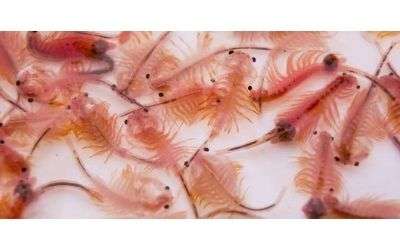Fish are the cold-blooded animal and they need the energy to make the body warm. In nature, fish eat several times daily if foods are available. Therefore, you should feed the fish as much as they can eat.
The challenging job is to keep the newly hatched fry live and healthy. Newly hatched fish cannot eat the same foods as the parents. They grow rapidly and need proper nutritional foods. For this, proper food with proper nutrition should be provided until the fry grow large enough to eat standard foods. Most of the aquarium fish hobbyists already know how to look after adult fish, but it is hard to feed the newly hatched fish fry.
Newly hatched fish have very tiny bodies, and they can only eat the smallest of foods. This stage is particularly critical because they can starve to death quickly. In this developmental stage, they eat different types of food. For example, newly hatched Discus fry take their parents’ slime coat for the first few days of life as food.
There are two common types of fish fry in nature. Among them, some fry hatch from eggs and others fry born live (live-bearer fish such as Guppies, Mollies, Platy, Swordtail, Four-Eyed Fish give birth baby fish/fry). Live-born fry are larger in size and they develop rapidly while fry from egg-laying fish are small in size and they often can`t free swimming for the first few days. Live-born fry also have comparatively large-sized mouth than the egg-hatched fry. Hence, live-born fry can take a small amount of similar foods as parent fish.
There are lots of foods with a high-quality nutritional value that most fry will do well on. These foods must be offered at the time the fry hatch, and the supply must be continuous until they are able to eat conventional foods. If the fry grow larger or pass their life one or two weeks, then they are able to take similar foods as the parents with just smaller portions. Practically all purchased foods, either flake, freeze-dried or pelleted food can be crushed to a fine size that fry are able to eat.
Many pet fish stores or online shops now offer food specifically designed for newly hatched fry. You may buy it from them that meet the nutritional requirements for your fish fry.
The best foods for newly hatched fry are live foods like freshly hatched brine shrimp, green water and infusoria. When the fry hatch, these foods should immediately offer them. If you do not have those foods, egg yolk and prepared fry foods can make good alternatives. This type of food does not need more times to prepare.
Live Foods
There are many lives foods that work well for newly hatched fish fry. Most popular live foods for newly hatched fish fry include:
- Baby brine shrimp;
- Vinegar eels;
- Micro-worms, and
- Infusoria-It includes both green water and zooplankton
Brine Shrimp
Brine shrimp (0.08 to 0.12 millimeter) are the best food for newly hatched fish fry. It is very popular fry food among the aquarium hobbyists due to its proper nutrients and protein-rich components. Most of the baby fish accept them as a staple food. Generally, they are active in freshwater and can live for up to five days. This type of food is used in the aquarium hobby frequently because, it is extremely easy to culture, and the eggs can be kept for years in a cool, dry place. You can hatch the eggs in a brine shrimp hatchery. After hatching the eggs, you can feed it to newborn fry within 24 to 48 hours.

Micro-worms
Micro-worms (Panagrellus redivivus) is one of the ideal foods for your newly hatched fish fry like betas, killifish, tetra, guppies, danios, gouramis, barbs, and many others. They are small sized nematodes which are 0.05 to 2.0 mm long and 0.05 mm in diameter. They are more suitable food for very small fry that are not able to eat baby brine shrimp. Micro-worms can live up to 25 days and a female micro-worm can produce 300 young during her lifetime. They prefer to live at a temperature below 32 0F, but optimum temperature for reproduction is ranged from 68-85 0F. Micro-worms contain 76% water, 24% Dry Matter, 40% Protein and 20% fat. You may culture them easily at home for your newly hatched fry.

Vinegar Eels
Vinegar eel (Turbatrix aceti) is a non-parasitic roundworm and it is also a great food for your recently hatched fish fry. They are very small in size with 0.04 to 2 mm in length and 0.10 mm in diameter. They are not the actual eel but culture in apple cider vinegar. Hence it is called Vinegar Eels. Vinegar eels can live often up to 24 hours in aquarium water. For this reason, they can`t pollute the aquarium water quickly. They provide a food to your newly hatched fry throughout the day. When fry will not accept prepared foods then vinegar eels make a special food for your fish fry. At present, cultured vinegar eels are often available in the online shop. You may also obtain them through a local aquarium society.
Infusoria
Infusoria refer to any microscopic or nearly microscopic organism that live in freshwaters such as protozoa like Amoebas, ciliates (Paramecium, Vorticella) and euglenoids (Euglena), unicellular algae (which form green water), rotifers and other small invertebrates. It is commonly used by the aquarium owners to feed the newly hatched fish fry. It is mainly used as a fry food during early development due to its size and nutritional content.
Green Water
Green water is a term for water that contains phytoplankton especially suspended single-cell algae. Nearly all are invisible to the naked eye and grow naturally with a significant number in most fish tanks particularly those have live plants. They can perform photosynthesis for their food production and convert nutrients in the water into food and make the base of the food chain in the aquatic ecosystem. Besides these, green water also contains some zooplankton like protozoa, Vorticella, and rotifers. This zooplankton takes phytoplankton as food to form the next link in the food chain. You can use green water as food for the fish fry that have tiny size with a small mouth. For feeding to your fish fry, you should mix phytoplankton with zooplankton to give your fish fry more variety to eat. Green water is now very popular because it makes an outstanding first food for fry. Especially, it is important to herbivore fry that require plant matter in their diet.
Prepared Foods
There are numerous prepared foods for newly hatched fish fry in the pet fish market. They are not alive but make excellent alternatives to live foods. Among them, popular prepared foods are:
- Liquid fish food;
- Boiled egg yolk;
- Powdered egg yolk and
- Commercial fry flake;
Liquid Fish Food
This type of food is suitable for newly hatched fish fry which always stays suspended long time in the water for small fish to eat them. It is favorable for the smaller fry to fit into their mouths. In recent, the popularity of this type of food is increasing day by day, especially among fish breeders. This food can make some of the components of the food more bio-available to fish. They can promote good health for your pet fish. In the pet fish market, different types of liquid fish food are available for your fish fry. You may pick one from them which meet the fish’s nutritional needs.
Boiled Egg Yolk
This is an easy and very inexpensive fish fry food. You may prepare it by boiling the egg. After boiling, you should remove the shell and egg white and take the yolk. You should place a small piece of the yolk in a small container with water and shake the container vigorously. As a result, egg yolk dissolves in water and you will get a suspended food that you can feed your newly hatched fish fry. If you have more unused yolk then you can keep them into a sealed container in the refrigerator for further use. In this case, egg yolk should not be kept for a long time in the fridge. Before applying the egg yolk into the aquarium, you should pass the mixture using a cloth to sieve out any remaining larger pieces of yolk. You can then dispense the solution of egg yolk promptly into the aquarium for your fish fry. Generally, you should not add more food to the aquarium, as it can cause pollution.
Powdered Egg Yolk
This type of fish food is commonly available in the pet fish stores. Powdered egg yolk contains many other substances such as vitamins and minerals which enhance fish growth. You can easily add it to an aquarium directly on top of the water or you may mix it with water before dispensing it into the aquarium. Typically, if you place it on the surface of the water, the food floats, but if you mix the food with water, it stays suspended for a short period before dropping to the floor of the aquarium. This type of food is excellent for newly fish fry. Because the powdered yolk is small in size than suspended egg yolk which makes it suitable for the smallest fish fry.
Commercial Fry Flake
Commercially fry flake is now available in the pet fish market. It is good for large fish fry such as livebearers (guppies, swordtails, platys, and mollies) and most cichlid fish. You should feed it to your fry with small amounts of food frequently.
Also read: Best Aquarium Fish Food
Final Words
Newly hatched baby fish are also called fry and when they become finger like size, they are referred to as fingerlings. If you raise newly hatched fish fry in your aquarium, you should feed once a day. You should not overfeed your fish, because, uneaten food can decompose and produce toxic by-products which can be harmful to the fish. If you do overfeed, you should try to remove any uneaten food on time using a net or siphon to prevent water pollution.
